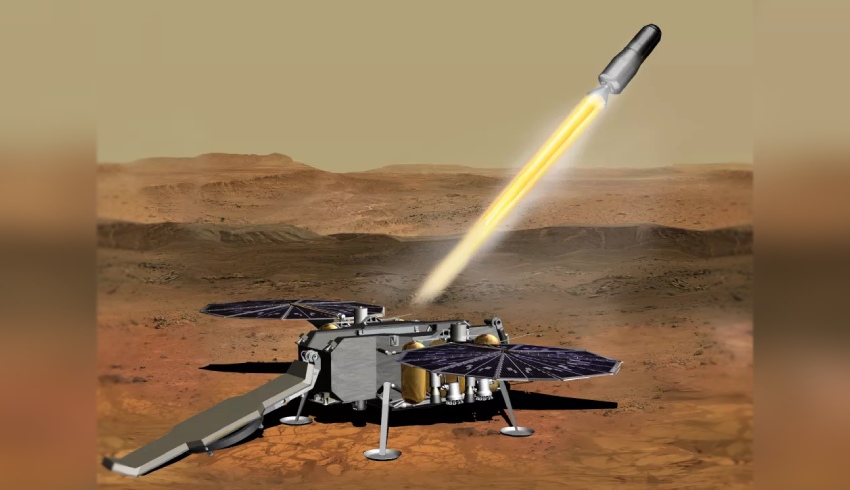
The news comes as Perseverance also just completed its first science campaign on the Jezero Crater and is preparing for its next mission on the Martian land.
The Mars Sample Return (MSR) program will see the first ever rocket launch from Mars and return samples collected by Perseverance back to Earth.
Lockheed Martin of Littleton, Colorado will build the Mars Ascent Vehicle (MAV), a small, lightweight rocket which will launch from the Red Planet.
A Sample Retrieval Lander (SRL) will carry MAV to Mars, landing near or in the Jezero Crater – where Perseverance has primarily scouted – to gather the samples cached by the rover.
Once the MSR mission is underway, the samples will be returned to the lander in a container, which will serve as the launch booster for the MAV.
When the MAV reaches the Mars orbit, the container will be captured by a European Space Agency (ESA) Earth Return Orbiter spacecraft outfitted with NASA’s Capture, Containment and Return System Payload, and blast back to Earth.
According to the NASA budget request, the agency will need to develop a “dual-lander architecture” that will carry the European built rover, moving the launch date to 2028. It was originally set to launch in 2026.
Pushing it back “is consistent with the Mars Sample Return Independent Review Board’s (IRB) finding that a dual-lander architecture may improve the probability of mission success”, the budget documents revealed.
“The MSR program will return the scientifically selected samples as early as 2033,” the documents continued, delaying the originally expected return date in 2031.
The budget request has allocated US$822 million to the MSR program in the fiscal year of 2023, which is an increase of last year’s US$169 million.
Perseverance completes first science campaign
Despite the announced delays over future Mars missions, NASA’s currently operating Perseverance rover has just wrapped up its first science campaign since landing on the Red Planet in July 2020, focused on studying the Jezero Crater floor.
The crater is a 45-kilometre-long stretch of land on Mars located on the Western edge of a flat plain called Isidis Planitia, which is north of the Martian equator.
It was chosen as a landing site for Perseverance as it is believed to have once been flooded with water, home to an ancient river delta.
During its time there, the rover learned the rocks making up the crater floor into two formations were igneous – type of rock solidified from lava or magma – in origin, according to Rachel Kronyak, systems engineer at NASA/JPL.
The first Perseverance encountered was the Máaz formation, in which it collected four rocks and sealed six sample tubes. The second was the Séítah formation, to which Perseverance performed abrasions on three rocks, and filled four sample tubes.
“All of this hard work has brought our total sample tube tally to 10 following our investigation of the Jezero Crater floor,” Kronyak said.
Up next, the rover will be driving towards its next campaign taking place at the Jezero Crater delta.
“I feel a deep sense of connection to the samples that Perseverance collects in Jezero Crater, and I’m very excited to see what the delta holds for us!” Kronyak added.

Isabella Richards
Bella Richards is a journalist who has written for several local newspapers, her university newspaper and a tech magazine, and completed her Bachelor of Communications (Journalism) at the University of Technology Sydney in 2020. She joined Momentum Media in 2021, and has since written breaking news stories across Space Connect, Australian Aviation and World of Aviation.
You can email Bella on: [email protected]
Receive the latest developments and updates on Australia’s space industry direct to your inbox. Subscribe today to Space Connect here.









